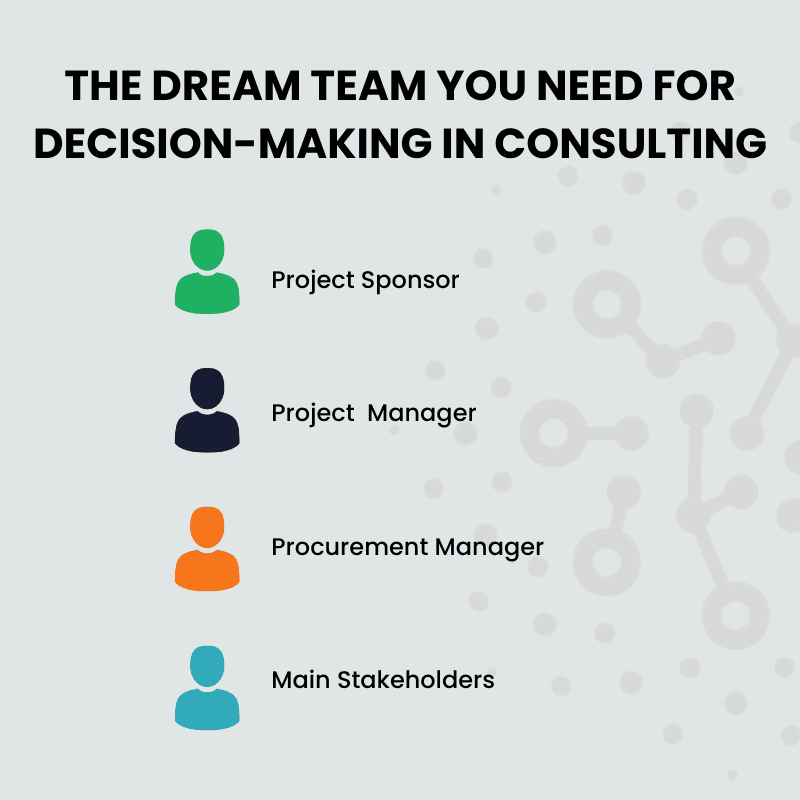So, you’re about to launch a massive consulting project, right? Feeling a little overwhelmed, are you? Well, don’t worry – that’s completely normal. Decision-making in consulting can be crucial, don’t you think? After all, this project is going to impact multiple functions and locations, so it’s a pretty big deal.
But before you start brainstorming your perfect outcome, let’s talk about the most important thing: getting the right people in the room. I mean, you don’t want a bunch of dummies nodding along to everything you say, do you? That’ll just be the recipe for a disaster.
Instead, take a page from John Wooden’s book and surround yourself with smart people who’ll argue with you. Yes, you heard that right – argue with you.
Because when you have a team of knowledgeable individuals with diverse perspectives, you can ensure that all aspects of the project are thoroughly considered and that potential challenges are addressed from multiple angles.
With the right group of experts on board, you’ll be well on your way to launching a successful consulting project. And if things get a little heated in the process, well, that just means you’re on the right track.
Your Team Plays a Critical Role In Decision-Making In Consulting – Who Should Be in the Room?
Deciding who should be in the room when making big decisions is one of the most important aspects of any decision-making process. Obviously, those directly affected by the decision should be involved, but there are other key players whose voices need to be heard as well.
Let’s take a look at who are the right people to be in the room during the decision-making process.
#1. Project Sponsor
Having a project sponsor is essential to ensure the success of the endeavor. They provide oversight and accountability while facilitating communication between different groups and stakeholders throughout the entire project lifecycle, from team members to leading executives.
In addition, they have the responsibility of representing the team and making sure that resources are managed efficiently. The project sponsor should not be mistaken with a project manager or leader as their primary focus is to act as an advocate for both internal and external growth, promoting the purpose of the project and measuring results against it.
Simply put, without an effective project sponsor, it’s hard for a successful project to take shape.
#2. Project Manager
A project manager is essential to success when it comes to completing a project. They have the authority and responsibility to bring the team together and keep track of progress, ensuring that tasks are completed on time.
A good project manager will constantly communicate progress with stakeholders, providing assurance that things are going as planned and gathering input for areas where help may be needed.
For any project or organization seeking to increase efficiency and productivity, having a supportive and experienced project manager leading the charge is key.
#3. Procurement Manager
Having a procurement manager present ensures that every step of the decision-making process is being done properly and efficiently. Their expertise in the area can help streamline the process substantially, making sure that it runs according to company policies and procurement best practices.
Above all else, those knowledgeable about procurement can make certain that the most cost-effective decisions possible are made for your business, potentially saving resources in the long run.
So, if you’re looking to ensure a smoother, simpler, and more efficient workflow – having a procurement manager in the room should be at the top of your list!
#4. Main Stakeholders
It’s true, if the main stakeholders don’t come on board with the project, chances are it won’t get off the ground. Everyone can offer something unique and valuable, that might contribute to making the project a success in ways we cannot foresee.
We must ensure that communication is open and honest between stakeholders so that everyone is aware of their potential roles and responsibilities – this way everyone can be fully involved in getting the project going.
It all boils down to commitment from all stakeholders; when we all share an understanding of what needs to be done, it sets us up for success!

Stepping into Larger Project Territory
Understanding the Shift to Strategic Projects
As you venture into the domain of larger consulting projects, the dynamics of decision-making evolve. While the stakeholders highlighted earlier remain integral to decision-making for any consulting project within your company, entering the domain of larger endeavors presents a distinct landscape. These larger projects are frequently synonymous with strategic initiatives, demanding a reevaluation of the decision-making process.
Even though strategy is not always an explicit stakeholder, the group is responsible for designing and executing business unit/corporate goals. And your project has a good chance to be a key piece of their action plan to make this strategy happen.
They will potentially be your ally in evaluating the strategic value of the project. But they might also have ideas in the scope of the project. In the same way, finance is interested first hand by how the consulting budget is spent.
If the project is large, you will have to convince them at some point in time that your project is strategic and worthy of the investment. Why not anticipate the objections and involve them early on? You will gain their support and probably shorten the decision-making process.
What is a Strategic Project?
You won’t like the answer… because it depends. The definition is linked to the size of your company and the extent of your consulting spend. In other words, for an SME, almost all consulting projects could be falling in that category when a large Fortune 1000 company could have a threshold of around $250k.
That’s it. We launched the keyword “Threshold.” It has a special place in our consulting sourcing bingo card, right next to “Demand Management.” Moreover, the best way to determine your threshold is to have a look at your consulting spend profile.
If you rank all projects from the last two years from the most expensive to the least expensive, where do you draw the line representing 80% of your spend? Now draw a second line representing 20% of the projects (starting with the most expensive). Your threshold is somewhere between these two lines.
To choose the right threshold, you need to take into account several elements:
- The degree of centralization for Procurement, Strategy & Finance
- The workload any given threshold would represent for these functions
- The flexibility your business lines will need to operate properly.
Beyond the Team: How to Handle Strategic Projects
There is no one-size-fits-all organization that will magically get you all the benefits in a snap. Depending on the volume of projects handled in the year, the level of centralization, or the strategic evolutions expected for the years to come, you have different options that could work.
#A. Have A Small Key Committee to Validate Large Projects
The decision to move on for strategic projects or projects above a certain threshold in value is validated through a small committee made with Procurement, Strategy & Finance. Projects afterwards are sourced and managed directly by operational teams.
Pros: Simple. Consistent with Strategy. Keeps Users reasonable.
Cons: Potential massive volume under management.
#B. Use A Multi-functional Team
Suppose managing consulting is a strategic objective, and the volume of projects is sufficient, but not enough to justify dedicated procurement professionals. In that case, you can consider building multi-functional teams to review projects over a certain threshold with a core triumvirate made of Procurement, Strategy & Finance.
This option will allow you to have more control over how projects are assessed and led. This option requires very clear processes and excellent collaboration between the different functions.
Pros: Flexible. Can adapt to the specific needs of a project.
Cons: Complexity of organization in case of large volumes.
#C. Implement A Strategic Committee
For companies with large consulting spend, the best option is assembling a team dedicated to consulting and integrating governance to decide on key projects. The procurement professionals will ensure all projects are assessed and involve the right players in the process.
They will bring more strategic projects to the committee that will have representatives of the major functions plus whoever is relevant based on your governance (leadership team member, transformation leader, etc.).
The centralization of decisions will allow you to focus your energy and resources on the most impactful projects. The same committee could also review priorities for internal projects.
Pros: Still Flexible. Alignment with Strategy.
Cons: A lower degree of decentralization can be a challenge for some companies. Requires enough critical mass to justify the costs.
Independent of whether you implement strict Demand Management or just filter projects based on the costs, you need to look closely at the most expensive projects to ensure they are strategic and timely.
For that purpose, you will need to have Strategy and Finance involved in the decision-making process. Embarking them early in the process will help keep the deadlines and smooth the validation.
Wrapping Up: Team Dynamics and Decision-Making in Consulting: Finding the Perfect Balance
When it comes to decision-making in consulting, building the right team is just the opening act. As projects get more strategic, so does the need for brainpower and teamwork. It’s not just about job titles; it’s about getting smart heads together to handle the mess.
Defining strategic projects means mixing strategy and results, and nailing this combo takes skill. The threshold, that magical line, brings strategy and budgets under one roof, keeping things in check.
But this isn’t where the show ends. Dealing with strategic projects needs a tailored approach. Small committees, all-star teams, and strategic setups—all are roads to better decisions.
Through all this, remember that diverse viewpoints make good choices. Embrace the crew, embrace strategic moves, and embrace teamwork. In the ever-changing world of consulting, let good judgment and innovation shine—a nod to smart choices and leaders who steer towards success.
As the curtain falls on the consulting drama, let your performance echo with the tune of victory—a tribute to sharp calls and leaders who know how to get things done.
decision-making in consulting decision-making in consulting decision-making in consulting
decision-making in consulting decision-making in consulting decision-making in consulting
decision-making in consulting decision-making in consulting decision-making in consulting
decision-making in consulting decision-making in consulting decision-making in consulting
decision-making in consulting decision-making in consulting decision-making in consulting

How Consource Can Help?
Consource introduces a new era of decision-making through collaboration. It enables stakeholders, buyers, and consultants to work together seamlessly, fostering effective choices and successful project outcomes.








0 Comments